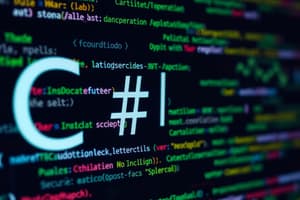Podcast
Questions and Answers
What is a compiler?
What is a compiler?
A program that translates a high-level language program into a separate machine language program.
What is an interpreter?
What is an interpreter?
A program that both translates and executes instructions in a high-level language program.
What are keywords in programming?
What are keywords in programming?
The words that make up a high-level programming language.
What do operators do?
What do operators do?
What is syntax in programming?
What is syntax in programming?
What are statements in a programming language?
What are statements in a programming language?
What is the maximum value for a byte?
What is the maximum value for a byte?
What is R.A.M?
What is R.A.M?
What are disk drives and solid state drives?
What are disk drives and solid state drives?
How is information stored on a disk drive?
How is information stored on a disk drive?
How is information stored on a CD/DVD?
How is information stored on a CD/DVD?
What is digital data?
What is digital data?
What is a digital device?
What is a digital device?
What is a logic error?
What is a logic error?
What is a syntax error?
What is a syntax error?
How many steps are there in the program development cycle?
How many steps are there in the program development cycle?
What is the basic order of operations?
What is the basic order of operations?
What is an initial variable?
What is an initial variable?
What is a constant variable?
What is a constant variable?
What is a global variable?
What is a global variable?
What do you surround all strings with in programming?
What do you surround all strings with in programming?
What is a string?
What is a string?
What is a string literal?
What is a string literal?
What two steps form the process of designing a program?
What two steps form the process of designing a program?
What is a hierarchy chart?
What is a hierarchy chart?
What is an argument in programming?
What is an argument in programming?
What is a parameter?
What is a parameter?
What are some synonyms for modules?
What are some synonyms for modules?
What must be done for a module to run?
What must be done for a module to run?
Flashcards are hidden until you start studying
Study Notes
Compiler
- Translates high-level language programs into separate machine language programs for later execution.
Interpreter
- Translates and executes high-level language instructions by converting them to machine language in real-time.
Keywords
- Reserved words in a programming language that cannot be used as variable names.
Operators
- Symbols that perform operations on data, including addition (+), subtraction (-), greater than (>), and less than (<).
Syntax
- A strict set of rules governing the structure of code, such as the use of quotation marks to denote statements.
Statements
- Individual instructions written in high-level programming languages to perform tasks.
255 bits
- Maximum value for a byte, which consists of combinations of 0s and 1s.
R.A.M
- Primary storage used for data processing; it temporarily holds data that the CPU accesses.
Disk drives, solid state drives
- Types of secondary storage devices used for data retention and retrieval over the long term.
Magnetically
- Method used for storing information on a disk drive.
Laser burning
- Technique for encoding data onto CDs and DVDs.
Digital data
- Information represented in binary format, consisting of 0s and 1s.
Digital device
- Equipment that operates using binary data, facilitating computing tasks.
Logic error
- An error that allows a program to run but results in incorrect output.
Syntax error
- A coding mistake that prevents a program from executing past the point of error.
Five steps
- The number of stages involved in the program development cycle.
Basic order of operations
- Multiplication and division take precedence over addition and subtraction during calculations.
Initial variable
- A type of variable recognized only within its module; can change throughout the program.
Constant variable
- A variable whose value remains unchanged throughout the program's execution.
Global variable
- A variable accessible from any part of the program, which can complicate programming logic.
Quotation marks
- Required punctuation used to surround strings in programming for interpretation as textual data.
String
- A data type comprised of a sequence of characters.
String literal
- A specific instance of a string represented directly in the program's source code.
Design process steps
- Understanding the task to be performed and determining the necessary steps to complete that task.
Hierarchy chart
- A visual representation showing the relationship between different modules in a program.
Argument
- A data piece passed from one module to another when calling a function or procedure.
Parameter
- A special type of variable that receives values (arguments) when a module is invoked.
Synonyms for modules
- Terms like procedures, functions, methods, and subroutines refer to code organization units.
Running a module
- A module must be called explicitly for it to execute and perform its designated tasks.
Studying That Suits You
Use AI to generate personalized quizzes and flashcards to suit your learning preferences.




